 Few words work when it comes to describing the kinetic joy and wonder that is WALL•E. Few words are appropriate because WALL•E himself only knows about three — all names.
Few words work when it comes to describing the kinetic joy and wonder that is WALL•E. Few words are appropriate because WALL•E himself only knows about three — all names. One of them is his own. “Wuuuh-allll-leeeee,” he bleeps with the goofy syntax of a talking ATM machine. His name is how he introduces himself. Added to his greetings are friendly little waves that don’t quite compute with the other robots, but the infectious act of waving overcomes them anyway. One robot, whose sole purpose is to type computer code at about 4 words per minute, seems absolutely baffled with WALL•E’s robot kindness: he pumps the hydraulic cylinders in his digits, gives his joints a twist, and voila, there he is waving back in all its innocent splendor.
 WALL•E, of course, is not a human, but a little robot in this computer-animated film. He has tank treads for feet, a little oven-like torso that opens and closes, and a head made of the most inquisitive pair of binoculars. I mentioned that WALL•E speaks with a limited vocabulary, but don't get the impression there's dialogue — vast stretches of the movie are almost silent. We don’t hear a human voice for a very long time and when we do, we kind of miss the robots and their more expressive dialect of bleeps and bloops. WALL•E is voiced — voiced mechanically and digitally, that is— by Ben Burtt, the sound designer who gave us the classic Star Wars sounds: Darth Vader’s breathing, that famous lightsaber noise and the entire language of R2-D2, who could easily be a close cousin to WALL•E.
WALL•E, of course, is not a human, but a little robot in this computer-animated film. He has tank treads for feet, a little oven-like torso that opens and closes, and a head made of the most inquisitive pair of binoculars. I mentioned that WALL•E speaks with a limited vocabulary, but don't get the impression there's dialogue — vast stretches of the movie are almost silent. We don’t hear a human voice for a very long time and when we do, we kind of miss the robots and their more expressive dialect of bleeps and bloops. WALL•E is voiced — voiced mechanically and digitally, that is— by Ben Burtt, the sound designer who gave us the classic Star Wars sounds: Darth Vader’s breathing, that famous lightsaber noise and the entire language of R2-D2, who could easily be a close cousin to WALL•E. This is not a feel-good movie at all. It’s a feel-great movie. It’s a movie so delightfully simple that it could be baby stuff, a notch or two above Teletubbies perhaps, but that’s part of its glorious charm — its simplicity is soothing and refreshing. In many ways it feels like a Charlie Chaplin film in its straightforward minimalism: entire sequences hinge on facial reactions, body language, movements of the eyes. This is Chaplin’s Little Tramp as a Xerox machine, a binary load lifter, a Roomba vacuum cleaner.
The story goes like this: mankind polluted Earth so badly that everyone decided to flee in big resort-style spaceships. Before blastoff, they left thousands of clean-up droids to clean the planet in man’s absence. After 700 years, only one of the robots, WALL•E, is still operable. Every day WALL•E shovels junk into his torso, grumbles mechanically for a bit and then spits out a compacted cube of trash. These cubes are stacked into the stratosphere, in parks where there was once trees and in the oceans where there was once water.
 We’re led to believe that WALL•E has some sort of glitch, which is what makes him so cheerful. Johnny 5 (Short Circuit) had the same problem, but he was never this cute or likeable. WALL•E has a friend, a little cockroach that might be a robot bug or a real roach; I could never tell. His home is filled with interesting bits of junk he finds in earth’s clutter: lawn gnomes, lighters, light bulbs, a lacy bra and one VHS tape, Hello, Dolly!, which he watches over and over again as its songs fill his little circuit boards first with happiness and later loneliness.
We’re led to believe that WALL•E has some sort of glitch, which is what makes him so cheerful. Johnny 5 (Short Circuit) had the same problem, but he was never this cute or likeable. WALL•E has a friend, a little cockroach that might be a robot bug or a real roach; I could never tell. His home is filled with interesting bits of junk he finds in earth’s clutter: lawn gnomes, lighters, light bulbs, a lacy bra and one VHS tape, Hello, Dolly!, which he watches over and over again as its songs fill his little circuit boards first with happiness and later loneliness. WALL•E functions cleverly as a robot. His movements are very mechanical, but also very fluid. A great amount of time was spent by animators to give him robot movements as opposed to human ones. When scared he compacts into a cube, when sad his binocular eyes droop, when he sees an attractive female robot his metal body goes limp and his eyes perk up — WALL•E’s movements sell this movie.
WALL•E functions cleverly as a robot. His movements are very mechanical, but also very fluid. A great amount of time was spent by animators to give him robot movements as opposed to human ones. When scared he compacts into a cube, when sad his binocular eyes droop, when he sees an attractive female robot his metal body goes limp and his eyes perk up — WALL•E’s movements sell this movie. 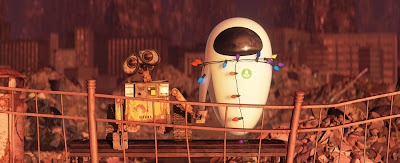 The plot eventually turns into a romance and goes into space after WALL•E meets Eve, a futuristic probe droid sent to Earth to collect what may be it’s only biological organism, a plant that WALL•E is growing out of an old boot. Eve, designed after an iPod no doubt, has captivated WALL•E’s attention so completely that those Hello, Dolly! love songs now have meaning to him. He tries many times, with little success, to hold her hand and at one point it builds up to the ultimate sign of his affection if only he could get the nerve to do it — apparently even robots get girl shy.
The plot eventually turns into a romance and goes into space after WALL•E meets Eve, a futuristic probe droid sent to Earth to collect what may be it’s only biological organism, a plant that WALL•E is growing out of an old boot. Eve, designed after an iPod no doubt, has captivated WALL•E’s attention so completely that those Hello, Dolly! love songs now have meaning to him. He tries many times, with little success, to hold her hand and at one point it builds up to the ultimate sign of his affection if only he could get the nerve to do it — apparently even robots get girl shy.I’ve written about the simplicity of this film, but that’s just one level. WALL•E does have an undercurrent of complexity running through it. Besides being a wonderful example of non-verbal communication skills and a rather heartbreaking romance, it can also be biting satire. When the film rockets into space we finally meet humans, who, after years of video games and holographic chambers, have become so obese they can no longer walk, or even get shoes on their pudgy feet. These gelatinous mounds chug soda, ride around in hovering wheelchairs and are bombarded by advertising so loud and obnoxious you’ll understand how Earth was wasted. This is heavy stuff, considering the movie is so light and effervescent. But if Al Gore's right, WALL•E's Earth could very likely be our Earth in about 100 years. It also touches on our consumption as a people — as Americans more specifically — and how affluenza might be our ultimate downfall. The fact that it's brave enough to embrace all this in its cutely animated arms adds another dimension to its charm.
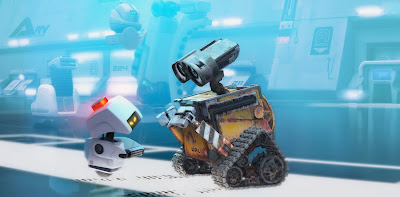
 On the ship with the blobby humans, we meet many other robots, including Mo, a cleaning robot that is perplexed at all the dirty tread tracks that are suddenly criss-crossing the ship. After WALL•E’s is captured and sent in for repairs — no one noticed he was the model from 700 years ago — we meet a motley crew of broken robots, each of which has more character than the normal-functioning ones. This leads to chases inside and outside the ship, a fight with the ship’s autopilot and various little one-off scenes with WALL•E and Eve as they grow on each other. There’s a hilarious sequence with the ship’s captain as he takes his first steps as the soundtrack cues Richard Strauss and 2001: A Space Odyssey. Oh and bring tissues: I’m predicting WALL•E will be a tearjerker for some. A good measuring stick can be applied here: If you cried in Iron Giant, you'll cry in this.
On the ship with the blobby humans, we meet many other robots, including Mo, a cleaning robot that is perplexed at all the dirty tread tracks that are suddenly criss-crossing the ship. After WALL•E’s is captured and sent in for repairs — no one noticed he was the model from 700 years ago — we meet a motley crew of broken robots, each of which has more character than the normal-functioning ones. This leads to chases inside and outside the ship, a fight with the ship’s autopilot and various little one-off scenes with WALL•E and Eve as they grow on each other. There’s a hilarious sequence with the ship’s captain as he takes his first steps as the soundtrack cues Richard Strauss and 2001: A Space Odyssey. Oh and bring tissues: I’m predicting WALL•E will be a tearjerker for some. A good measuring stick can be applied here: If you cried in Iron Giant, you'll cry in this. I’ve neglected to tell you what company made this film, but it won’t be any surprise — Pixar Animation Studio. This is one of Pixar’s best, but isn’t every one? (Cars might be the exception.) WALL•E is animated beautifully: the space scenes are clean and crisp, the Earth scenes muddled and hazy, and the robots are wonderful and inventive. Surely this is as good as The Incredibles, Finding Nemo or Toy Story, maybe better considering it does more with basically no voice actors.
I’ve neglected to tell you what company made this film, but it won’t be any surprise — Pixar Animation Studio. This is one of Pixar’s best, but isn’t every one? (Cars might be the exception.) WALL•E is animated beautifully: the space scenes are clean and crisp, the Earth scenes muddled and hazy, and the robots are wonderful and inventive. Surely this is as good as The Incredibles, Finding Nemo or Toy Story, maybe better considering it does more with basically no voice actors. 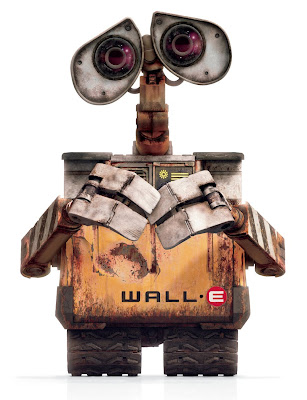 It’s geared for younger children, but adults should surrender their age at the door and come out as amazed as the little viewers will. WALL•E is, so far, the best film of the year, a delicately crafted fantastically original human drama that stars no humans at all.
It’s geared for younger children, but adults should surrender their age at the door and come out as amazed as the little viewers will. WALL•E is, so far, the best film of the year, a delicately crafted fantastically original human drama that stars no humans at all.***This review originally ran in the West Valley View June 27, 2008.***
And just because I love the photos, here's more:

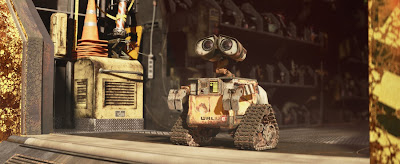

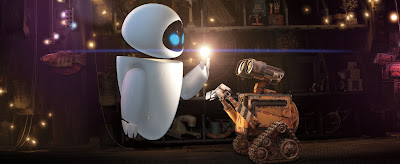

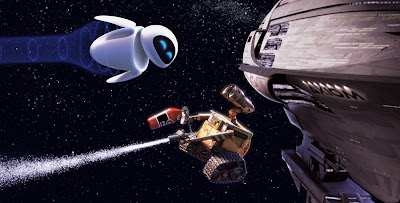
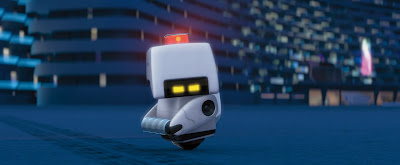
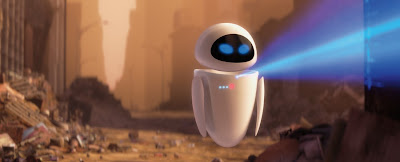

No comments:
Post a Comment